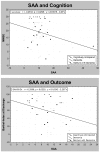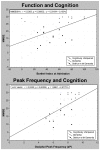Serum anticholinergic activity and cerebral cholinergic dysfunction: an EEG study in frail elderly with and without delirium
- PMID: 18793418
- PMCID: PMC2564970
- DOI: 10.1186/1471-2202-9-86
Serum anticholinergic activity and cerebral cholinergic dysfunction: an EEG study in frail elderly with and without delirium
Abstract
Background: Delirium increases morbidity, mortality and healthcare costs especially in the elderly. Serum anticholinergic activity (SAA) is a suggested biomarker for anticholinergic burden and delirium risk, but the association with cerebral cholinergic function remains unclear. To clarify this relationship, we prospectively assessed the correlation of SAA with quantitative electroencephalography (qEEG) power, delirium occurrence, functional and cognitive measures in a cross-sectional sample of acutely hospitalized elderly (> 80 y) with high dementia and delirium prevalence.
Methods: 61 consecutively admitted patients over 80 years underwent an extensive clinical and neuropsychological evaluation. SAA was determined by using radio receptor assay as developed by Tune, and standard as well as quantitative EEGs were obtained.
Results: 15 patients had dementia with additional delirium (DD) according to expert consensus using DSM-IV criteria, 31 suffered from dementia without delirium (D), 15 were cognitively unimpaired (CU). SAA was clearly detectable in all patients but one (mean 10.9 +/- 7.1 pmol/ml), but was not associated with expert-panel approved delirium diagnosis or cognitive functions. Delirium-associated EEG abnormalities included occipital slowing, peak power and alpha decrease, delta and theta power increase and slow wave ratio increase during active delirious states. EEG measures correlated significantly with cognitive performance and delirium severity, but not with SAA levels.
Conclusion: In elderly with acute disease, EEG parameters reliable indicate delirium, but SAA does not seem to reflect cerebral cholinergic function as measured by EEG and is not related to delirium diagnosis.
Figures


References
-
- ML Ancelin, Artero S, Portet F, Dupuy AM, Touchon J, Ritchie K. Non-degenerative mild cognitive impairment in elderly people and use of anticholinergic drugs: longitudinal cohort study. Bmj. 2006;332:455–9. doi: 10.1136/bmj.38740.439664.DE. - DOI - PMC - PubMed
-
- Trzepacz PT. Is there a final common neural pathway in delirium? Focus on acetylcholine and dopamine. Semin Clin Neuropsychiatry. 2000;5:132–48. - PubMed
Publication types
MeSH terms
Substances
LinkOut - more resources
Full Text Sources
Medical

